ADEX 2011 Report
Is Carbon Fiber the new Aluminum
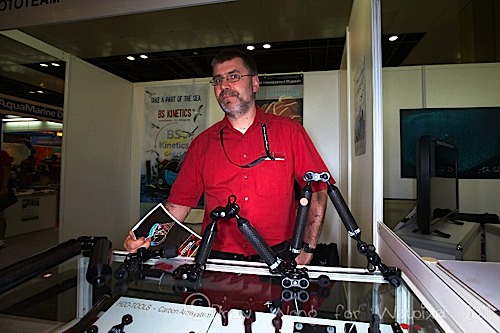
Stefan of AquaFoto Team posing with his Carbon Armsystem
I’d heard about some manufacturer in Germany using Carbon fiber to build light arms They were apparently much light than traditional aluminum arms and best of all, they added buoyancy. As Aqua-Foto Team were situated right next to Scubacam so I jumped at the chance to finally see them.
The Carbon Arm system are buoyant arms, with ball heads made to the same dimensions of Ultra Light Control System ball heads, so there’s cross compatibility. The arms have the tensile strength of 8000kg and compression strength of 400kg. The ball heads are screwed in with 8mm aluminum screws and specially bonded with a glue that keeps the water out, giving it natural bouyancy.
These’s arms are 25mm in diameter and are very light compared to aluminum arms. As physics says, the longer the arms, the more buoyancy there is (as you can see in the chart below). Stefan also had 2 prototype 20cm(8”) 29mm diameter arms which had 200gm buoyancy. These arms will be shipping in May. For those using glass domes and heavy housings, these arms seem to be the best option. Not only are they lighted for air travel but they are also buoyant. The best of both worlds>
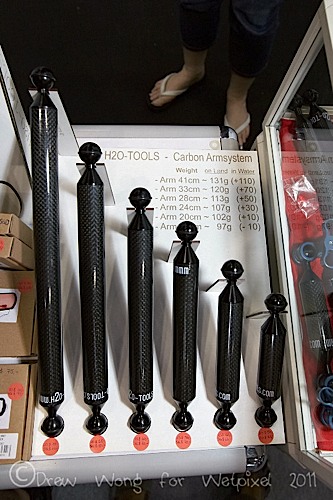
The H20 Tools Carbon Armsystem with size/buoyancy chart
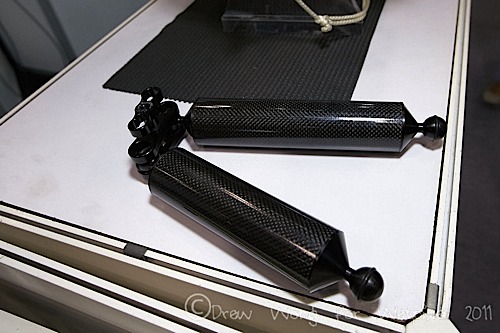
The prototype 29mm diameter arms (shipping in May)
Sharing the booth with Stefan was Bodo Sutterer from BS Kinetic, the housing manufacturer which uses Carbon Fiber instead of Aluminum. Eric Cheng has a write up on the Duo Dive 3D housing. The carbon housings tend to be more buoyant than Aluminum housings. I actually want to strap a thermometer in the housings to see the difference in temperature between the 2 materials.
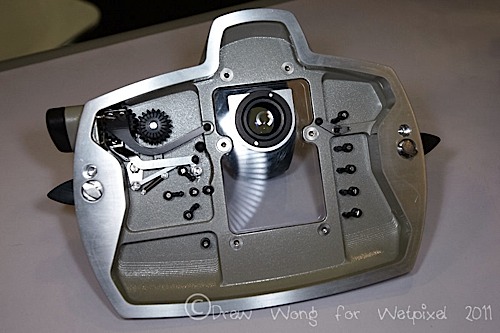
Bodo Sutterer and the BS Kinetic booth.
In my brief discussion with Bodo, he did confirm that the new CX700/NX70 cameras have disabled their LANC software, whereby if AV component output is on, then LANC does not work. Apparently every other manufacturer is suffering from the same problem and everyone is playing catch up with Sony’s firmware changes.
Seashells for All (well, for many!)
For the point and shoot crowd, there was the SeaShell housing, universal housings that can be adjusted to fit hundreds of compact point and shoot cameras. They are rated to 40m, shockproof up to 1m and can be used down to -10°C.
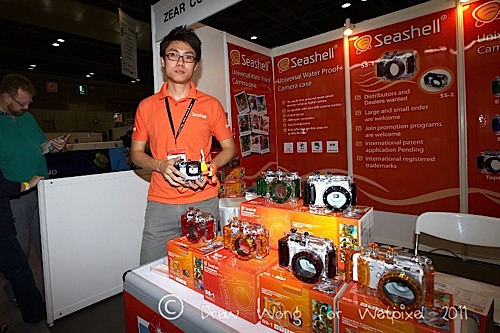
Seashell universal housings from Hong Kong
There are 2 models, the SS-1, which is designed for cameras with extending lenses (over 600 models covered) and the SS-2, which is for non-extending lens models (over 200 models). The polycarbonate housing no controls except the ON/OFF switch and shutter control, so everything has to be preset before installing into the housing.